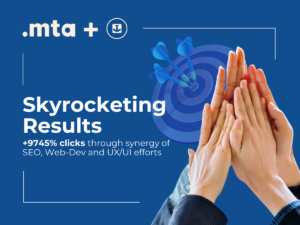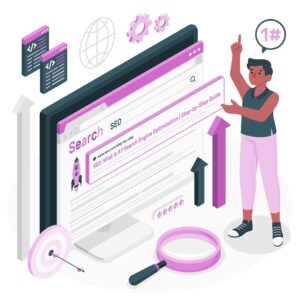Website migration is, despite appearances, an extensive and quite complicated process based on coordinated activities of specialists. Ultimately, the migration should be carried out without technical problems and without any consequences in the form of traffic loss. In this case study, you will find out how we achieved it twice, additionally increasing the organic traffic results!
Migration plan
The websites in question are bigberkeywaterfilters.com and ohpolly.com. The former is a retailer of highly regarded Berkey water filters both in the US and Europe, while the latter is a British clothing brand specializing in women’s fashion.
Both sites boast really impressive levels of organic traffic, so the task was a real responsibility and there was no room for error. Any mistake could have cost our partners a lot of time, money, and customer trust.
In the case of both described projects, we started by planning the whole process. Such a plan included every action that, in our opinion, should be taken during the migration. We based the process on 4 stages of working on the website.
These are divided into:
- Planning
- Pre-launch
- Launch
- Post Launch
Such a division supports the work of PMs, but also specialists, as it arranges the whole process, making it easier to control. Especially if you opt for the checklist form, which can be easily managed and which you can continuously verify what still needs to be done.
Our plan was based on estimating the potential impact of the migration on the website. Simply establishing that organic traffic to the site should not be lost is not enough. We needed a breakdown of all ranking factors for the pages to be migrated, as well as the components of the site. This provided a better picture of the entire project and was a good starting point for planning further actions.
During the migration, the website is inactive for some time (usually it should be as short as possible), so we decided to launch the new version at times corresponding to the time zone of the largest user pool. The best performing time of day is night (3 – 4 am), as this is when overall user traffic is usually at its lowest.
Another action that underlines our comprehensive approach to digital is to choose an alternative traffic acquisition channel that, at least initially, will boost the migrated site. Without a doubt, the best move is to bet on PPC campaigns (GAds + FB Ads) and this is what we have proposed to our clients.
Preparations for migration
The plan itself is not everything. Preparing data for analysis or other resources is also necessary to be able to evaluate the quality and effectiveness of the migration carried out at all.
Such activities included:
- Verification of noindex tags in a test environment (the so-called stage version of the site)
- Performing a crawl of the old version of the site so that no URL was missed
- Exporting lists of data for analysis (list of visited subpages, list of posts with external links, and list of subpages indexed in Google)
- Keyword research
- Building a structure of URLs on a new page
- Creation of a redirection map and creation of a .htaccess file on its basis
- Collecting data on the performance of the old version
- Generating a new robots.txt file together with the sitemap
- Creating a backup copy of the previous version of the website
The last part of planning is choosing suitable specialists (apart from the Project Manager, it should be an SEO specialist, webdeveloper, and, if possible, a UX specialist) . Our team in both projects consisted of all the above-mentioned experts.
We combined this choice with the specification of all general migration-related as well as specifically assigned tasks for both clients. The aforementioned activities allowed us to make an orderly transition into the real migration process.
Work on the migration
After such preparations, there remained the implementation of individual issues, such as the new graphic design of the website, putting it together, and implementing technical solutions.
These were typical web development tasks, which allowed us to move on to the phase close to launching the new version of the website after migration. After creating the new, migrated version of the website, we were able to verify the actions, basing on the actual work done by the specialists.
We checked such elements as:
- Performance comparison of the old and new site (Core Web Vitals and other metrics from PageSpeed Insights from Google)
- Canonical links
- Potentially broken links
After these steps we were ready to launch the migrated domain, obviously taking into account the next key steps that allowed the new version of the site to be indexed and crawled correctly. Without this, it would have been impossible to achieve a smooth transition between the two versions without losing organic traffic.
These actions include:
- Ensuring search engine robots have access to the new page
- Verifying noindex tags – removing them and leaving them on relevant subpages
- Checking the correctness of 301 redirects
- Checking the sitemap for correctness
- Implementing new meta title and meta description at the start
- Verification of the presence of so-called soft 404 on the page
- Verification of the presence of codes for analytical tools (Google Analytics, Hotjar)
- Checking follow attributes on internal links
In addition, our UX specialist conducted a cognitive walkthrough, which is a structured approach to evaluating product usability. It involves asking a research group (this included people from both within and outside our organisation) 4 questions about how a person navigates the site.
This allowed us to draw conclusions for potential improvements to the site in the future, as well as catching some issues worthy of improvement right away.
Verification – organic traffic and technical issues
Once the process of both migrations was complete, it was time to verify the results. This is why it was so important to collect data on the old version of the website at earlier stages.
We divided the data comparison into:
Conducting a performance test of the new site and comparing the results with the previous version


Verifying the indexation status of the new site and comparing the results with the old version – here, too, the data overlapped with the previous version of the site, however, it was combined with certain improvements (we excluded some of the old addresses in order to increase the crawl budget of the site)
Checking the number of hits on subpages through the search engine and comparing the results with the old version – the most pleasant part of the results verification, in both cases not only did we not lose traffic, but we gained it in combination with an upward trend for the following months.


Summary
There is more evidence of the effectiveness of our two migration processes, unfortunately, we cannot disclose them due to the assumptions of the agreements made with partners. However, we are sure that we are fully prepared to carry out such a process, and we have gathered our experience operating on really large, thriving sites.
Are you interested in the migration process itself? Website migration as a guide can be found on our blog. We encourage you to read this material, which will successfully help you to go through all the migration issues and problems on your own.
Would you like to delegate this task to specialists? We will be happy to support you in complex migration activities. Feel free to contact us via the contact form below, and also check out our full range of SEO services!







